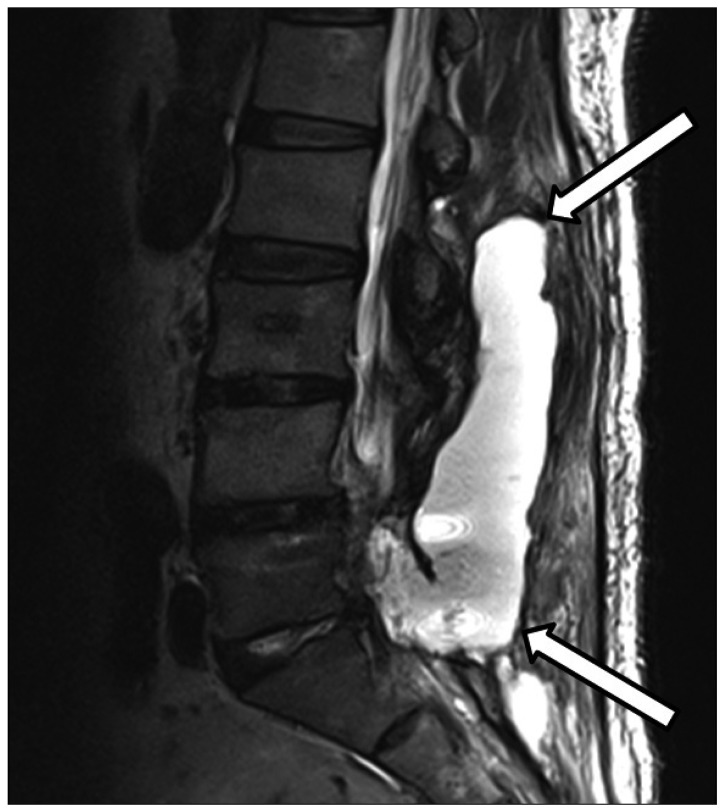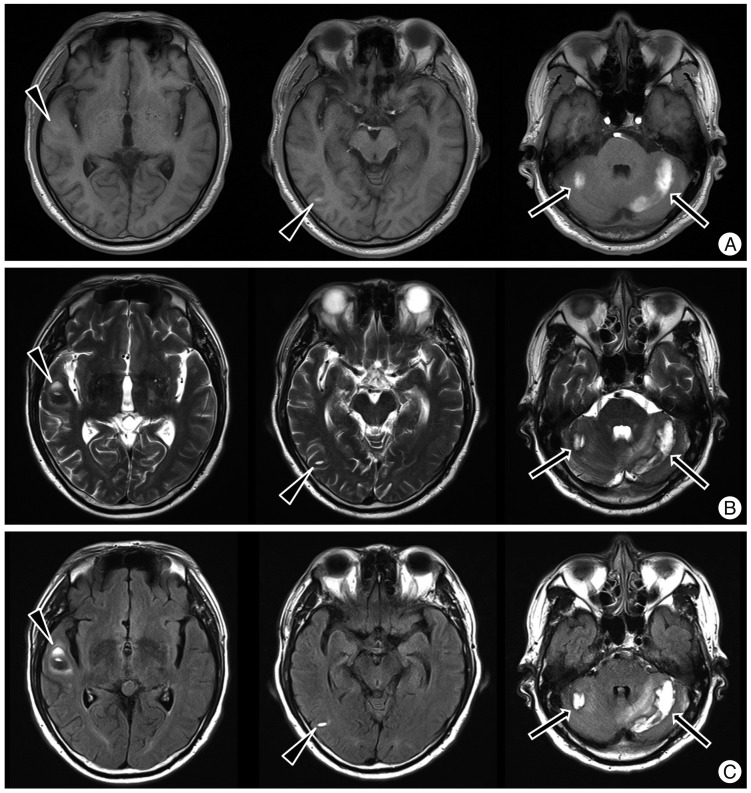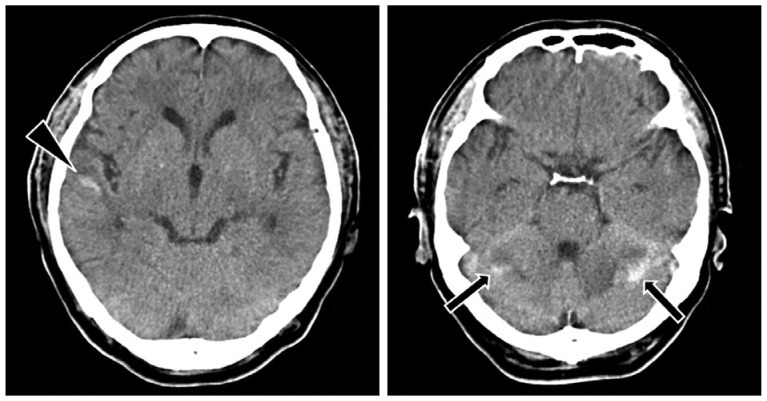Remote Cerebral and Cerebellar Hemorrhage after Massive Cerebrospinal Fluid Leakage
- Affiliations
-
- 1Department of Radiology, Korea University Anam Hospital, Seoul, Korea. kyurad@gmail.com
- 2Department of Neurosurgery, Korea University Anam Hospital, Seoul, Korea.
- KMID: 2066920
- DOI: http://doi.org/10.3340/jkns.2012.51.4.240
Abstract
- Dural tears can occur during spinal surgery and may lead to cerebrospinal fluid (CSF) leakage which is rarely involved in remote cerebellar hemorrhage. Only a few of cases of simultaneous cerebral and cerebellar hemorrhage have been reported in the English literature. We experienced a case of multiple remote cerebral and cerebellar hemorrhages in a 63-year-old man who exhibited no significant neurologic deficits after spinal surgery. Magnetic resonance imaging (MRI) performed 4 days after the surgery showed a large amount of CSF leakage in the lumbosacral space. The patient underwent the second surgery for primary repair of the dural defect, but complained of headache after dural repair surgery. Brain MRI taken 6 days after the dural repair surgery revealed multifocal remote intracerebral and cerebellar hemorrhages in the right temporal lobe and both cerebellar hemispheres. We recommend diagnostic imaging to secure early identification and treatment of this complication in order to prevent serious neurologic deficits.
MeSH Terms
Figure
Cited by 3 articles
-
Risk factors of postoperative remote intracerebral hemorrhage after craniotomy for ruptured cerebral aneurysms
Insu Lee, Cheol Wan Park, Chan Jong You, Dae Han Choi, Kwangwoo Park, Young Bo Kim, Woo Kyung Kim, Gi-Taek Yee, Myeong-Jin Kim, Eun Young Kim
J Cerebrovasc Endovasc Neurosurg. 2020;22(2):53-64. doi: 10.7461/jcen.2020.22.2.53.Remote Cerebellar Infarction after Supratentorial Craniotomy and Its Management: Two Case Reports
Seon-Jin Yoon, Chang-Ki Hong
Brain Tumor Res Treat. 2015;3(2):141-146. doi: 10.14791/btrt.2015.3.2.141.Cerebellar Hemorrhage after Posterior Lumbar Decompression and Interbody Fusion Complicated by Dural Tear - A Case Report -
Byung Wan Choi, Sang Min Lee, Min Geun Yoon, Myung Sang Moon
J Korean Soc Spine Surg. 2014;21(4):183-188. doi: 10.4184/jkss.2014.21.4.183.
Reference
-
1. Amini A, Osborn AG, McCall TD, Couldwell WT. Remote cerebellar hemorrhage. AJNR Am J Neuroradiol. 2006; 27:387–390. PMID: 16484416.2. Andrews RT, Koci TM. Cerebellar herniation and infarction as a complication of an occult postoperative lumbar dural defect. AJNR Am J Neuroradiol. 1995; 16:1312–1315. PMID: 7677032.3. Bowers CA, Taussky P, Duhon BS, Schmidt MH. Multiple supra- and infratentorial intraparenchymal hemorrhages presenting with seizure after massive sacral cerebrospinal fluid drainage. Spine (Phila Pa 1976). 2011; 36:E288–E291. PMID: 21270696.
Article4. Brockmann MA, Groden C. Remote cerebellar hemorrhage : a review. Cerebellum. 2006; 5:64–68. PMID: 16527766.5. Brockmann MA, Nowak G, Reusche E, Russlies M, Petersen D. Zebra sign : cerebellar bleeding pattern characteristic of cerebrospinal fluid loss. Case report. J Neurosurg. 2005; 102:1159–1162. PMID: 16028781.
Article6. Friedman JA, Ecker RD, Piepgras DG, Duke DA. Cerebellar hemorrhage after spinal surgery : report of two cases and literature review. Neurosurgery. 2002; 50:1361–1363. discussion 1363-1364. PMID: 12015857.
Article7. Hashidate H, Kamimura M, Nakagawa H, Takahara K, Uchiyama S, Kato H. Cerebellar hemorrhage after spine surgery. J Orthop Sci. 2008; 13:150–154. PMID: 18392920.
Article8. Honegger J, Zentner J, Spreer J, Carmona H, Schulze-Bonhage A. Cerebellar hemorrhage arising postoperatively as a complication of supratentorial surgery : a retrospective study. J Neurosurg. 2002; 96:248–254. PMID: 11838798.
Article9. König A, Laas R, Herrmann HD. Cerebellar haemorrhage as a complication after supratentorial craniotomy. Acta Neurochir (Wien). 1987; 88:104–108. PMID: 3687495.
Article10. Konya D, Ozgen S, Pamir MN. Cerebellar hemorrhage after spinal surgery : case report and review of the literature. Eur Spine J. 2006; 15:95–99. PMID: 16007466.
Article11. Morandi X, Riffaud L, Carsin-Nicol B, Guegan Y. Intracerebral hemorrhage complicating cervical "hourglass" schwannoma removal. Case report. J Neurosurg. 2001; 94:150–153. PMID: 11147853.
Article12. Nam TK, Park SW, Min BK, Hwang SN. Remote cerebellar hemorrhage after lumbar spinal surgery. J Korean Neurosurg Soc. 2009; 46:501–504. PMID: 20041065.
Article13. Thomas G, Jayaram H, Cudlip S, Powell M. Supratentorial and infratentorial intraparenchymal hemorrhage secondary to intracranial CSF hypotension following spinal surgery. Spine (Phila Pa 1976). 2002; 27:E410–E412. PMID: 12634578.
Article14. Yoshida S, Yonekawa Y, Yamashita K, Ihara I, Morooka Y. Cerebellar hemorrhage after supratentorial craniotomy--report of three cases. Neurol Med Chir (Tokyo). 1990; 30:738–743. PMID: 1708447.
- Full Text Links
- Actions
-
Cited
- CITED
-
- Close
- Share
- Similar articles
-
- Subarachnoid Hemorrhage Presenting with Seizure due to Cerebrospinal Fluid Leakage after Spinal Surgery
- Remote Cerebellar Hemorrhage after Lumbar Spinal Surgery
- Remote Cerebellar Hemorrhage after Intradural Disc Surgery
- Remote Cerebellar Hemorrhage due to Cerebrospinal Fluid Leakage or Meningitis after Spinal Surgery: Case Report
- Remote Cerebellar Hemorrhage after Spinal Surgery




